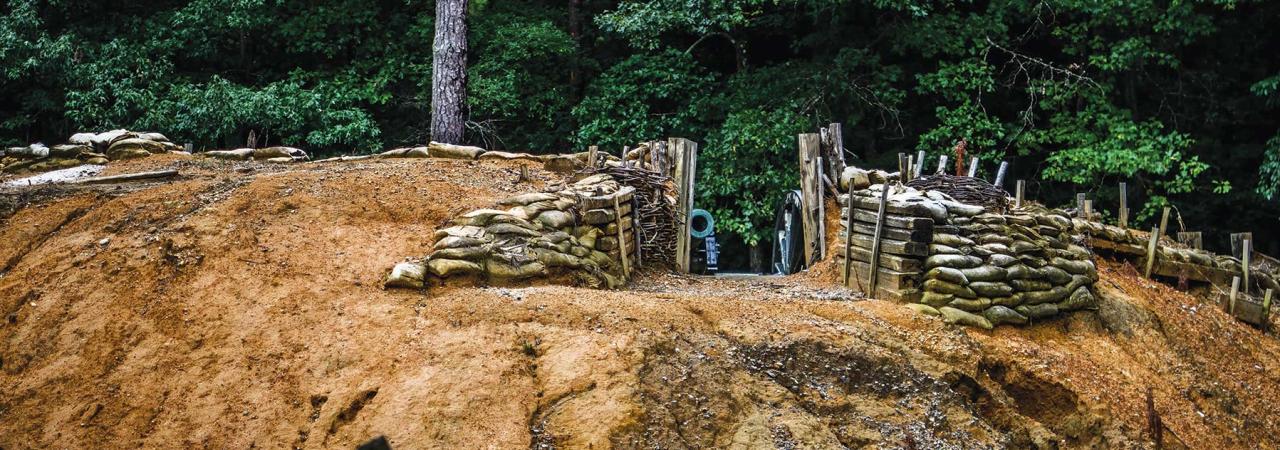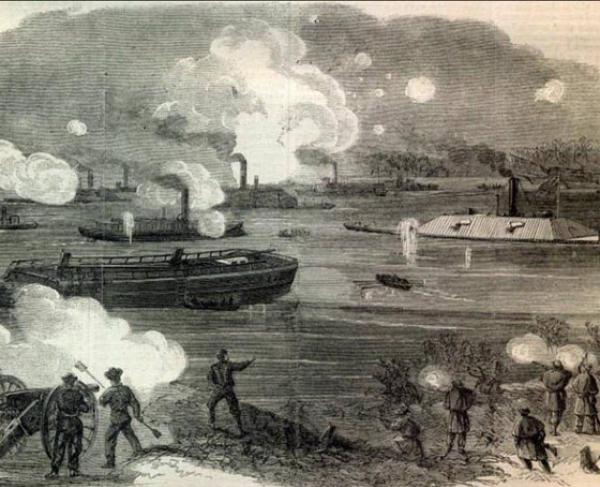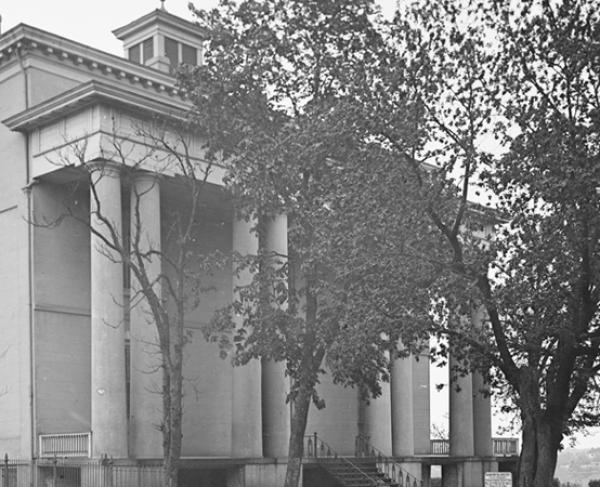
For nine months, the Confederate defenses of Petersburg held firm against repeated Federal assaults. They could not hold forever.
At 4:00 p.m., on April 1, 1865, with heavy combat just beginning around the Five Forks intersection, Union Maj. Gen. George G. Meade wrote instructions for Maj. Gen. Horatio G. Wright’s VI Corps to attack the main line of Confederate entrenchments early the next morning. Some Union soldiers, upon hearing the order, believed it was an April Fools’ joke; the Petersburg Campaign was in its 291st day, but no frontal assaults had been launched since July 30 of the previous year, and those had resulted in the failed debacle at the Crater. Many considered the Confederate fortifications located one mile away to be the strongest line of works they had faced during the war.
For nine and a half months, Gen. Robert E. Lee’s Army of Northern Virginia had clung to the trenches outside of Petersburg and their capital at Richmond 20 miles to the north, searching for opportunities to lash out at Union columns as the bluecoats wound their way through the embattled countryside looking for opportunities to cut the next in a series of Confederate supply lines. Lee and his veterans had performed admirably in preventing the capture of the two cities, but by 1865 they could only depend upon a handful of routes across which they could receive supplies — or along which they could escape, if necessary.
While Lee and Lt. Gen. Ulysses S. Grant traded blows outside of Petersburg, other Union armies sliced through what remained of the Confederacy, capturing Atlanta, conquering the Shenandoah Valley and tightening the blockade. Clear Union success outside of central Virginia buoyed Northern enthusiasm for the war’s prospects and provided the foundation for President Abraham Lincoln’s landslide reelection. While the rallying cry “On to Richmond” had guided the Army of the Potomac during the first years of the war, Grant placed the capture of the Confederate capital as a secondary objective in 1864, focusing his efforts on destroying the Confederate economy, agriculture and transportation infrastructure, as well as the citizens’ willingness and armies’ ability to fight.
After the initial assaults in mid-June 1864 failed to conquer Petersburg, Grant adopted a strategy of utilizing one-two punches to threaten both Richmond and Petersburg — cavalry raids along the railroads and infantry pushes around the Confederate right flank — with the goal of encircling Petersburg south of the Appomattox River. Though doing so gained limited territory, Grant used Maj. Gen. George G. Meade’s Army of the Potomac to keep constant pressure against the Confederate capital and its supply hub to the south, preventing Lee from relieving crumbling armies in other theaters.
Before the campaign had even matured, Lee realized the inevitable doom of remaining static in the trenches around the two cities but, unlike when he had faced previous opponents, he could not wrest the initiative away from Grant. In March 1865, Lee determined the best way to regain momentum and prevent his entrapment was to boldly strike against the Military Railroad, an improvised line built by Union engineers to connect the soldier encampments on the front lines at Petersburg with the supply base at City Point, a deep-water port at the confluence of the James and Appomattox Rivers.
The desperate Confederate gamble on the morning of March 25 succeeded in the temporary capture of Fort Stedman, but could not sever the railroad. After Maj. Gen. John G. Parke’s IX Corps reclaimed its lost position, gathering several thousand prisoners along the way, Meade instructed Wright and Maj. Gen. Andrew A. Humphreys to test the strength of the Confederate lines southwest of the city. The VI and II Corps successfully seized the Confederate rifle pits along their fronts and refaced them, forcing the Southern pickets to create a new line closer to their own fortifications, increasing the chances of a successful Union frontal assault at that sector.
However, Grant had already written instructions for his next offensive against Petersburg, one that stressed maneuver but did not dismiss the practicality of a frontal assault. He instructed Maj. Gen. Edward O.C. Ord to bring reinforcements from the Army of the James — then threatening Richmond on the north side of its namesake river — south to Petersburg to relieve the II Corps and Maj. Gen. Gouverneur K. Warren’s V Corps from their entrenched encampments. Humphreys and Warren would then move toward the Boydton Plank Road, one of Petersburg’s two remaining open supply lines. The infantry columns would also serve to screen Maj. Gen. Philip H. Sheridan’s cavalry, recently arrived from the Shenandoah Valley, which was to move through Dinwiddie Court House for the South Side Railroad. Expecting Lee to shift the Confederate dispositions to protect those lines, Grant instructed Parke, Wright and Maj. Gen. Godfrey Weitzel, who remained with the rest of the Army of the James near Richmond, to launch attacks against the Confederate entrenchments if they appeared weakened.
Warren, Humphreys and Sheridan set out on March 29, gaining Dinwiddie Court House without a contest and capturing another stretch of the Boydton Plank Road several miles closer to Petersburg after a brief engagement at Lewis Farm. Lee reacted to these developments by summoning what reserves he could spare — the cavalry under his nephew, Maj. Gen. Fitzhugh Lee, and Maj. Gen. George E. Pickett’s infantry division — while transferring additional troops from their position closer to the city along the Boydton Plank Road to one four miles south along Hatcher’s Run. The departure of a brigade-and-a-half from around the Tudor Hall plantation opposite Wright’s VI Corps left 10 regiments numbering 2,800 soldiers to man a mile-and-a-half-long stretch that, four days later, faced the brunt of an attack by Wright’s entire command.
March 30 proved to be a wash, heavy rains delaying the offensive for a day. His superiors having sensed the stretched Confederate position, Wright received orders to attack the section of the Confederate line near Tudor Hall the next morning, but those orders were ultimately, albeit temporarily, countermanded. Instead, Warren absorbed a withering, though outgunned, Confederate attack that day and eventually drove the Southerners back into their entrenchments along the White Oak Road, severing the link between the main line and Pickett, farther to the southwest, who spent the day driving Sheridan back to Dinwiddie Court House.
Joined by Warren on April 1, Sheridan designed an attack against Pickett’s position at the Five Forks intersection. With major combat in just its initial stages around that critical junction at 4:00 p.m., Meade sent the instructions for Wright to attack the Confederates in his front the following morning.
The VI Corps’s commander set about plans to form all but one regiment of his command, some 14,000 men, in front of its own works near Fort Welch, using the position gained during the combat on March 25 as a staging ground. During the previous week, Brig. Gen. Lewis A. Grant had used the advanced position of the Union picket line to scout for weaknesses along the Confederate entrenchments. Grant had identified a narrow ravine, the headwaters of Arthur’s Swamp that wound its way from near Tudor Hall plantation toward the Union lines, widening as it flowed southeast.

The marshy landscape had been covered by thick pine woods when the armies arrived the previous October, but the encamped troops had timbered the ground over the course of their occupation. This ultimately exposed the ravine to view from the advanced picket position and, as the action shifted farther to the southwest, the beleaguered Confederates did not view the ravine as a point of sensitive vulnerability.
Lewis Grant pointed the ravine out to Brig. Gen. George W. Getty, commanding the division, who passed the intel up to Wright and Meade, who both consented. Wright then set about devising specific instructions for his looming attack. Thus the Federal subordinate generals had already designated their objective, identified their tactics and written preliminary orders for the assault when Grant expanded Meade’s previous plan to include an attack all along the lines.
After learning of the Union victory at Five Forks — and with it his preordained sacking of Warren — Grant wanted to continue to press the Confederates along the entire front. The overall Union commander frequently worried that he would wake up one morning and find the Confederates had evacuated Petersburg and Richmond, leaving his heavier, slower columns in their wake in a race he could not win. His dismissal of the unaggressive Warren and standing attack orders to Wright, Parke and Weitzel were intended to prevent that possibility. Now, on the evening of April 1, Grant wanted to immediately follow up the good news from Five Forks with simultaneous attacks all across the front. However, Ord reported the terrain too difficult on his front, and Meade stated the impracticability of subordinates attacking that night. The Army of the Potomac’s commander instead chose to continue the plan he set forth in his previous orders that afternoon.
Around midnight, Wright’s men filed out of their trenches near Fort Welch and began forming behind their own picket line a half mile to their front, halfway across the distance between the rival sets of entrenchments. The Confederate sentries, just a quarter mile out in front of their own main works, sensed the activity and fired blindly into the darkness. The VI Corps suffered significant casualties from the sporadic fire, losing two mortally wounded regimental commanders, as well as the temporary loss of Lewis Grant to a head wound. Sharp discipline, including the muffling of wounded comrades and the removal of percussion caps from their rifle muskets, prevented excessive noise and any return fire that could tip the Confederates off to the strength of the gathering force.
By 1:00 a.m., April 2, Wright’s men reached their designated locations in front of Fort Welch. Grant’s brigade of six Vermont regiments, now under command of Lt. Col. Amasa S. Tracy, formed in a column, with their left flank anchored along Arthur’s Swamp. The 5th Vermont Infantry lay just behind the Union picket line, with the 2nd, 6th, 3rd, 4th and 1st Vermont Heavy Artillery (acting as infantry) stacked to their rear. Getty’s other two brigades, under Cols. Thomas W. Hyde and James M. Warner, similarly formed assault columns in echelon on the Vermonters’ right rear. Brig. Gen. Frank Wheaton continued the formation on the right flank, deploying the brigades of Cols. Oliver Edwards, James H. Penrose and Joseph E. Hamblin in compact formation, with each to the right rear of the previous. Meanwhile, Brig. Gen. Truman Seymour placed his two brigades, under Cols. J. Warren Keifer and William S. Truex, on the opposite side of Arthur’s Swamp, each deployed in three rows to the left-rear of Getty.
The bluecoats lay silent on the cold, damp ground until 4:40 a.m., when a signal fired from Fort Fisher spurred them to their feet. Rushing forward into the darkness, the Federals crossed the several hundred yards to the Confederate rifle pits without incident. Passing over the startled sentries, who jogged the opposite way as prisoners, the attackers began to bog down once they struck the several lines of abatis in front of the Confederate earthworks.
Two companies of the 5th Vermont Infantry continued to rush forward at the tip of the wedge formation. Capt. Charles Gilbert Gould mistook a shout to “bear to the left” as a direct order and led 50 Vermonters out of the ravine. While his command bottled up as they sought to squeeze through a gap in the abatis, the young officer bolted ahead, scrambled up the ditch and mounted the parapet, saber in hand to contend with any Confederates he might encounter.
One of his comrades later recalled: “Capt. Gould rushed into the fort all alone, with nothing but his sword. The rebels came at him with swords, bayonets, and clubbed muskets. One bayonet was thrust into his mouth and through his cheek, and while in that position he killed the man with his sword. An officer struck him on the head with a sword and he was struck in the shoulder by a bayonet and pounded all over with clubbed muskets; but he gave as good as he got.”
Corp. Henry Recor rushed forward and hauled his battered captain’s body back into the relative safety of the ditch below the earthworks. Meanwhile, Sgt. Jackson Sargent and Corp. Nelson Carle scaled the embankment and planted the regimental and national colors on the earthworks. As a dazed Gould was led to the rear, handfuls, then dozens, then hundreds of Vermont infantrymen entered the thinly held Confederate works. After desperate hand-to-hand fighting — short in duration, but intense in violence — the outnumbered Southerners began surrendering en masse or retreating for Petersburg’s inner defenses.
The elated bluecoats pushed on through the Confederate encampments. Some stopped to rummage for souvenirs, while others pushed ahead for the Boydton Plank Road and the South Side Railroad beyond. Eventually, Wright swung his command south to Hatcher’s Run, sweeping the Confederates along the way before returning north to threaten Petersburg’s inner works.

Ord’s command spearheaded the final push toward Petersburg’s inner lines, overrunning brief, though desperate, defenses at Forts Gregg and Whitworth. Federal divisions elsewhere fought on a wide front — Parke’s IX Corps battled against fierce Confederate resistance southeast of the city at Fort Mahone, a II Corps division secured a lodgment on the South Side Railroad farther to the west at Sutherland Station, and Sheridan cautiously pressed northward from Five Forks.
After learning of the death of Lt. Gen. A.P. Hill — who was shot by two Pennsylvanians on their return from wrecking the railroad on their own initiative — Lee telegrammed the Confederate war department that he could see no further possibility of holding Petersburg past nightfall. He advised the government’s immediate withdrawal from the capital and made plans to begin pulling his soldiers out of the trenches at both Petersburg and Richmond that evening.
Lee hoped to unite the various scattered commands of his army at Amelia Court House, where they could follow the Richmond & Danville Railroad south toward North Carolina. But the decisiveness of Wright’s victorious charge ultimately prevented that possibility. After frantic evacuations from both Petersburg and Richmond, the Confederate army could not gain ample breathing room to escape Grant’s pursuit.
One week later, on April 9, the Federals caught up to Lee at Appomattox Court House, where the Confederate general surrendered. President Jefferson Davis nevertheless sought to reestablish the capital elsewhere, but the losses of the Army of Northern Virginia and Richmond convinced Southern generals elsewhere to yield the cause during the ensuing month.
Union casualties for the dramatic assault that came to be known as The Breakthrough totaled fewer than 4,000 — significantly less than at far more famed battles. Yet they contributed to one of the most decisive events of the war: the surrender of Lee’s army and the capture of Richmond. Capt. Gould — who survived his harrowing ordeal as the first soldier to reach the parapet during the Breakthrough, but was hampered by the lingering effects of his wounds for the remainder of his life — ultimately received the Medal of Honor for his sacrifice. Despite this, he had one thing on his mind when he wrote to inform his family of his tremendous participation that morning: “Am only sorry that I was wounded before I got into Richmond.”
Related Battles
3,500
4,250



